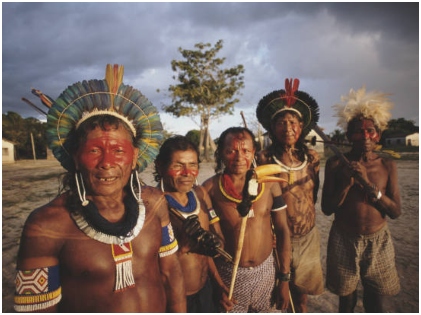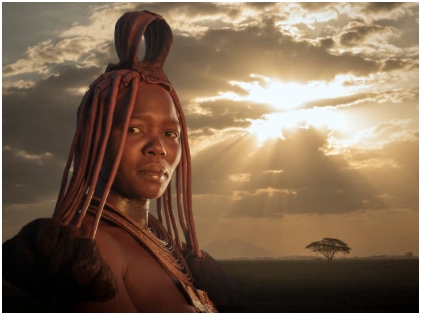Most of the unconnected tribes live in the deepest, darkest corners of the Earth. Come to think of it, the customs, dress, and traditions of these remote tribes have not changed all over the years.
You may think how do these people live a life away from civilization? Well, things are gradually changing for them too. These are some of the most incredible indigenous tribes in the world; find out what makes them truly unique.
Huli Wigmen, Papua New Guinea
 This tribe living in the Tari Highlands, Papua New Guinea wears hats that are made out of their own hair. Not only that men belong to this 40,000 strong group, harvest their mane as they use their own mane or sell it to the others.
This tribe living in the Tari Highlands, Papua New Guinea wears hats that are made out of their own hair. Not only that men belong to this 40,000 strong group, harvest their mane as they use their own mane or sell it to the others.
Their look is pretty unique as they wear, yellow, face paint, a clawed ax, a belt consisting of dangling pigtails. Another unique feature that sets them apart is that they mimic the birds of paradise. However, things are changing for this tribe as well; modern civilizations are changing the way things are going; so you may see now more of Western-style clothing even embracing modern tourism all the while keeping their tradition alive.
Dogon, West Africa
 The Dogon tribe lives in Mali in West Africa; use ropes made out of baobab bark to scale the Bandiagara cliffs collect pigeon or bat guano, which works as a fertilizer. The Tellem artifacts are available here and are sold to Western art collectors. The village too is precariously perched along the entire length of the 200 km cliff escarpment and around 400,000 live there. The tribe here is dependent on tourism; although they are facing some issues currently, we are sure they are going to come out of the rough patch pretty soon.
The Dogon tribe lives in Mali in West Africa; use ropes made out of baobab bark to scale the Bandiagara cliffs collect pigeon or bat guano, which works as a fertilizer. The Tellem artifacts are available here and are sold to Western art collectors. The village too is precariously perched along the entire length of the 200 km cliff escarpment and around 400,000 live there. The tribe here is dependent on tourism; although they are facing some issues currently, we are sure they are going to come out of the rough patch pretty soon.
Chimbu Skeleton Dancers, Papa New Guinea
The tribe’s skeleton dances are what sets them apart from the rest of the tribes. It started as they began to intimidate enemy tribes for territorial conquests. Not much is known about the remote tribespeople and their real lives. They live in a temperate climate in rugged mountain valleys between 1,600 and 2,400 m. Although their homes are segregated in a way that men and women live in separate houses; now more and more people are living together as families. Tourism in this part of the world is catching up too, so we may see them embrace modernity in the years to come.
Nenet of Siberia
This group of tribes has around 10,000 nomads and they cover great distances of almost 1,100 km; they walk around 300,000 reindeer. The distance covered is almost one-and-a-half times the size of France, and the temperature almost drops down to 50 degrees Celsius.
They usually travel on sleds in trains that stretch for almost 8km long. The area is in the spotlight because of the discovery of oil and gas reserves in the 1970s and things are progressing for them. They are slowly but surely acclimatizing to the changing scenario in their part of the world, be it social, political, or natural.
Asaro Mud Men
The Asaro mud men are covered in mud as men slap on the brown stuff because they believe it makes them look like spirits and terrifies the other indigenous groups in the area. They are one of the few groups living on the highland plateau for over a millennium; however, they are isolated by harsh terrain. Their tribe was discovered only 75 years ago. They are slowly emerging as a major tribe and their potential is gradually being discovered.
Awá From Brazil
They are often named the world’s most endangered tribe. There are only 100 of the Awá’s roughly 600 members; and they cover the entire Amazon forest covering Brazil’s border with Peru, as per an in-depth National Geographic report. They are constantly under threats from illegal logging and wildfires, yet they are constantly fighting all the harsh challenges.
Himba Herders of Namibia
 The semi-nomadic, people live all across northwest Namibia and southern Angola. They live in tipi-shaped structures that are made up of mud and dung. They pay homage to the ancestral fire burning 24 hours paying homage to their God Mukuru. Their wealth is measured in cattle. Their people count is dwindling and there are only 20,000 to 30,000 members of the tribe left. However, modern civilization is impacting them in more ways than one and their traditional lifestyle is also changing, however, the future of the tribe remains sketchy.
The semi-nomadic, people live all across northwest Namibia and southern Angola. They live in tipi-shaped structures that are made up of mud and dung. They pay homage to the ancestral fire burning 24 hours paying homage to their God Mukuru. Their wealth is measured in cattle. Their people count is dwindling and there are only 20,000 to 30,000 members of the tribe left. However, modern civilization is impacting them in more ways than one and their traditional lifestyle is also changing, however, the future of the tribe remains sketchy.
While the whole world is bound by global connectivity, there are some people who choose to stay unconnected and uncontacted. However, things are gradually changing for them too, but will they embrace change and choose to live like the rest of the world? Only time will tell.





